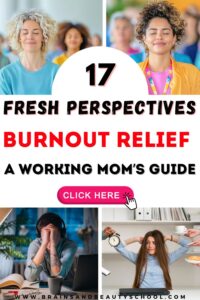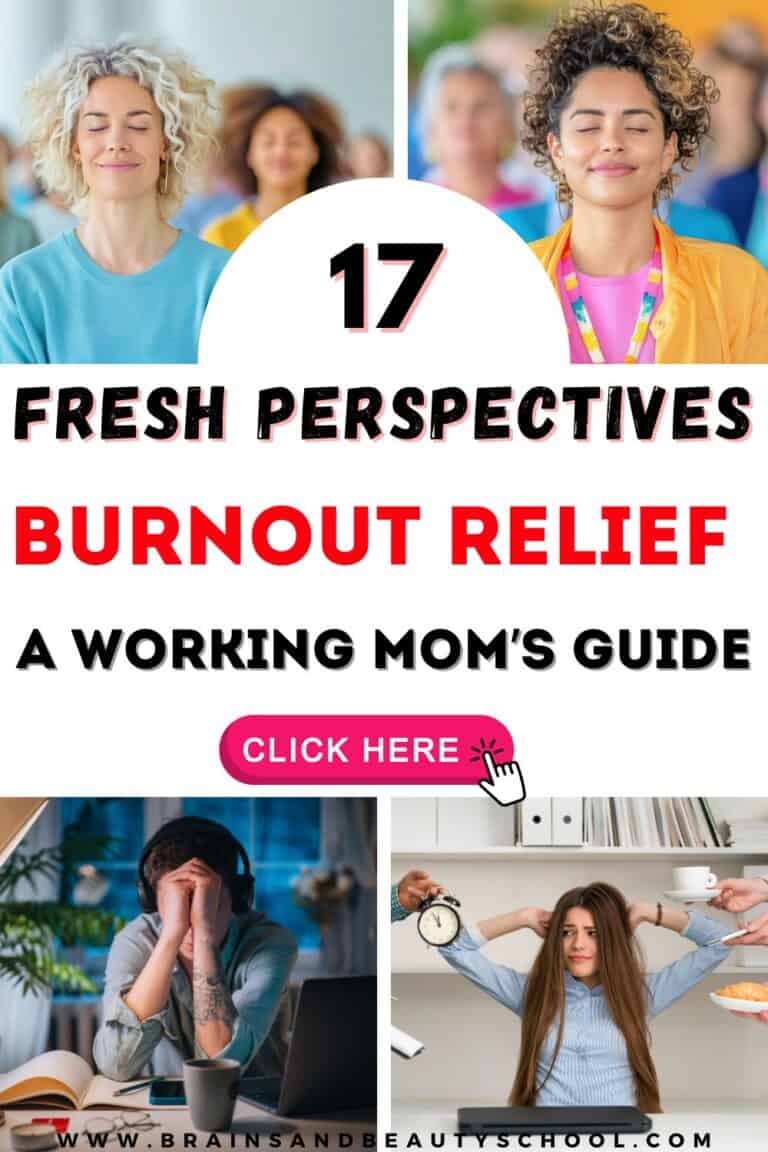
Burnout: A Guide for Working Moms in Their 30s
Understanding the nuances of burnout is essential, not only to recognize its symptoms but also to equip ourselves with the tools necessary for recovery. This article aims to encourage working moms, providing practical strategies for managing stress and avoiding burnout while celebrating the unique challenges they face.
Understanding Burnout
Burnout is characterized by emotional, physical, and mental exhaustion caused by prolonged stress. For working moms, this may manifest as a feeling of being overwhelmed, depleted, or detached from daily responsibilities. According to the American Psychological Association, about 60% of working mothers experience burnout, making it a significant issue that demands attention.
17 Signs of Burnout
Here’s a list of 17 signs of burnout that can help identify when someone might be experiencing this condition:
- Chronic Fatigue: Persistent exhaustion that doesn’t improve with rest.
- Insomnia: Difficulty falling asleep or staying asleep, often due to racing thoughts.
- Reduced Performance: A noticeable decline in work efficiency and productivity.
- Cynicism: Developing a negative or cynical attitude toward work or home life.
- Emotional Exhaustion: Feeling drained emotionally and unable to cope with stress.
- Physical Symptoms: Frequent headaches, stomach issues, or unexplained aches and pains.
- Social Withdrawal: Isolating oneself from friends, family, or colleagues.
- Lack of Motivation: A diminished interest in tasks that once seemed enjoyable or fulfilling.
- Forgetfulness: Increased forgetfulness or difficulty concentrating on tasks.
- Increased Irritability: Heightened sensitivity and frustration over small issues.
- Neglecting Self-Care: Ignoring personal needs, such as hygiene or nutrition.
- Feeling Overwhelmed: A constant sense of being overwhelmed by responsibilities.
- Detachment: Feeling disconnected or indifferent toward work or personal relationships.
- Decreased Satisfaction: Lowered sense of accomplishment or fulfillment in one’s role.
- Frequent Illness: Increased susceptibility to colds, flu, or other illnesses.
- Mood Swings: Experiencing significant mood fluctuations, including sadness or anger.
- Substance Use: Turning to alcohol, drugs, or other substances to cope with stress.
Recognizing these signs early can help individuals seek support and make necessary changes to prevent burnout.
Recognizing these signs is the first step toward reclaiming your well-being. The impact of burnout goes beyond the individual, affecting families and workplaces alike, underscoring the need for effective strategies to combat this growing concern.
The Pressure of Dual Roles
The dual responsibilities of a working mom can feel like an endless juggling act. From attending meetings and completing work projects to managing household chores, meal prep, and children’s activities, the mental load can become overwhelming. The concept of the “mental load” refers to the invisible work that moms do, often unrecognized and unshared.
Do you ever feel so exhausted but wonder why because you know your physical activity that day was limited? How much did you use your mind for family scheduling to go smoothly, and doing your best at your job?!
I found this hilarious post:
Consider the experience of Sarah, a marketing manager and mother of two. On any given day, she manages work deadlines while also planning family meals, coordinating her children’s extracurricular activities, and ensuring everyone is ready for school. The pressure of these responsibilities can lead to mental fatigue and an overwhelming sense of inadequacy when things don’t go as planned.
Real-Life Example: Sarah’s story is not unique. Many moms find themselves stretched thin, often feeling guilty for not doing enough, whether at work or home. This cycle of self-criticism contributes to burnout, making it crucial to find strategies to ease the burden.
17 Perspectives on Burnout in Women
Here are 17 fresh perspectives on burnout that can provide insight and encourage a deeper understanding of the issue:
- Burnout as a Signal: Rather than just a negative outcome, burnout can be viewed as a signal from the body and mind that changes are needed in one’s life or work environment.
- Cyclical Nature: Burnout is not linear; it can fluctuate based on life circumstances, work demands, and personal challenges, emphasizing the importance of ongoing self-awareness.
- Holistic Approach: Addressing burnout requires a holistic approach, considering physical, emotional, mental, and social aspects of well-being rather than focusing solely on work-life balance.
- Cultural Influences: Recognizing how workplace culture, values, and expectations can contribute to burnout, particularly in high-pressure environments.
- Role of Technology: Exploring how constant connectivity and technology can exacerbate feelings of burnout, as the lines between work and personal life blur.
- Community Support: Emphasizing the importance of social support systems—friends, family, and colleagues—as protective factors against burnout.
- Personal Values Alignment: Reflecting on how burnout can stem from a disconnect between personal values and the demands of one’s job or home life.
- Creative Outlets: The role of creative activities as a powerful antidote to burnout, allowing for expression and rejuvenation outside of work responsibilities.
- Mindfulness Practices: Incorporating mindfulness and meditation as essential tools for managing stress and preventing burnout, fostering present-moment awareness.
- Flexibility in Work Arrangements: The potential benefits of flexible work arrangements in reducing burnout, promoting autonomy and control over one’s schedule.
- Redefining Success: Challenging societal definitions of success and productivity that contribute to burnout, advocating for personal and individualized definitions instead.
- Learning from Setbacks: Viewing burnout as an opportunity for growth and self-discovery, learning valuable lessons about limits, resilience, and self-compassion.
- Nature and Well-Being: Exploring how time spent in nature can counteract burnout, promoting mental health and restoration.
- Empowerment through Advocacy: Encouraging individuals to advocate for changes within their organizations to create a healthier work environment that prioritizes well-being.
- The Power of Breaks: Acknowledging that regular breaks, both short and long, are crucial for maintaining energy and preventing burnout rather than being viewed as time wasted.
- Developing Emotional Intelligence: Enhancing emotional intelligence as a strategy to manage stress and improve relationships, reducing the risk of burnout.
- Engaging in Lifelong Learning: Promoting continuous learning and personal development as a way to rekindle passion and prevent stagnation, which can lead to burnout.
These fresh perspectives can help individuals and organizations better understand and address burnout, fostering a more supportive and resilient environment.
Strategies for Managing Burnout
Prioritizing Self-Care
Self-care is often the first thing to go when life gets busy, but it is essential for maintaining balance. Prioritizing self-care can help replenish energy and reduce stress levels.
- Tips for Incorporating Self-Care:
- Schedule “Me Time”: Block out time in your calendar for activities that rejuvenate you, whether it’s reading a book, practicing yoga, or enjoying a bath.
- Mindfulness Practices: Consider incorporating mindfulness or meditation into your routine. Apps like Headspace or Calm can guide you through short sessions that help clear your mind and reduce stress.
Setting Boundaries
Setting boundaries is critical to managing burnout. Learning to say no can create space for what truly matters.
- Tips for Work-Life Separation:
- Communicate Clearly: Share your boundaries with colleagues and family. For instance, if you need uninterrupted time to complete a project, let your team know.
- Establish a “Shutdown” Ritual: Create a routine to signal the end of your workday, such as shutting down your computer, turning off notifications, or taking a short walk.
Seeking Support
Building a support network can make a significant difference in managing stress. Friends, family, and professional networks can provide encouragement and practical help.
- Case Study:
- Jane, a single mother and teacher, found relief by joining a local support group for working moms. The shared experiences and advice from other mothers helped her realize she was not alone in her struggles, providing a sense of community and understanding.
Encouragingly, many workplaces are beginning to recognize the importance of mental health and offer support programs for employees, making it easier for moms to seek help without fear of stigma.
Encouragement for Working Moms
It’s essential to recognize the strength and resilience that working moms embody. Celebrating small wins can serve as motivation and a reminder of your capabilities.
- Inspiring Quotes:
- “You are not a drop in the ocean. You are the entire ocean in a drop.” – Rumi
- “The only way to do great work is to love what you do.” – Steve Jobs
Remember that progress is often incremental. Acknowledge your achievements, no matter how small, and allow yourself grace during challenging times. Your ability to juggle numerous responsibilities is a testament to your strength as a mother and professional.
Stories of Resilience: Many mothers have shared their journeys through burnout, highlighting the lessons learned along the way. For example, a woman who once felt overwhelmed found peace by prioritizing her mental health, allowing her to return to work with renewed vigor and perspective.
Recognizing and addressing burnout is crucial for working moms striving to balance their professional and personal lives. By understanding the signs, implementing self-care strategies, setting boundaries, and seeking support, moms can reclaim their well-being and thrive in both roles.
This journey may not always be easy, but the strength and resilience within every working mom can illuminate the path forward. Remember, you are not alone—many women share your experiences, and together we can create a supportive community for one another.
FAQ Section
- What are the signs of burnout for working moms?
- Common signs include chronic fatigue, irritability, lack of motivation, and feelings of overwhelm.
- How can I find time for self-care as a busy mom?
- Prioritize scheduling “me time” into your calendar, and consider quick mindfulness practices throughout your day.
- Is it normal to feel overwhelmed as a working mother?
- Yes, many working mothers feel overwhelmed due to the dual responsibilities of their professional and home lives.
- What support systems can I tap into?
- Consider joining support groups, connecting with friends, or seeking professional counseling for added support.
- How do I set boundaries without feeling guilty?
- Communicate clearly with family and colleagues about your needs and create routines that reinforce your boundaries.
This article serves as both a guide and a source of encouragement for working moms navigating the challenges of burnout. By implementing the strategies outlined, embracing resilience, and seeking support, moms can create a more balanced and fulfilling life. Remember, self-care is not a luxury—it’s a necessity for thriving in all aspects of life.









